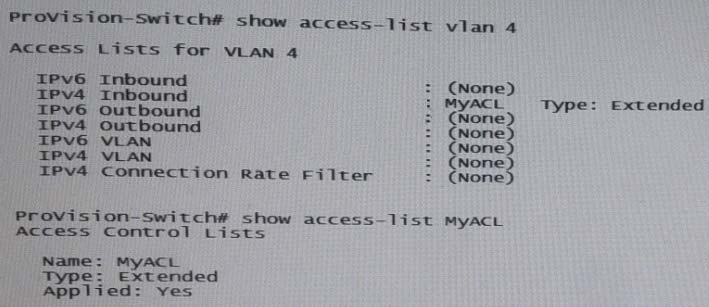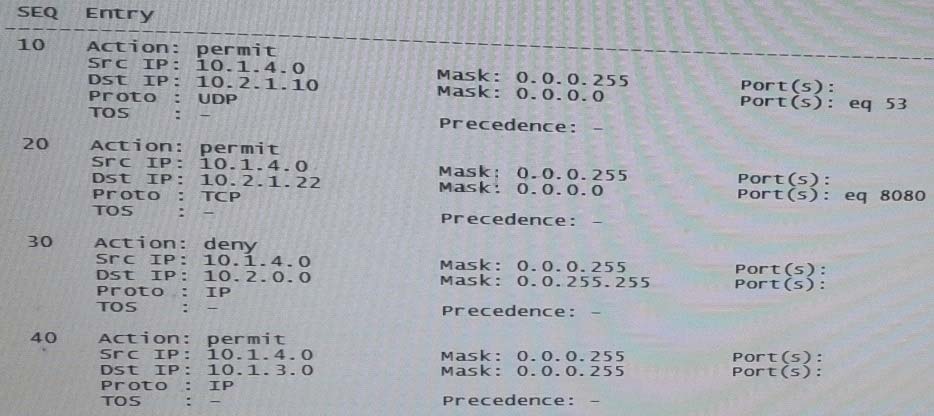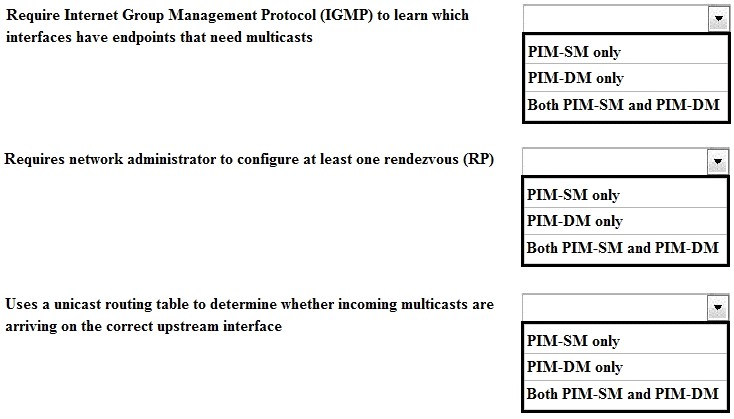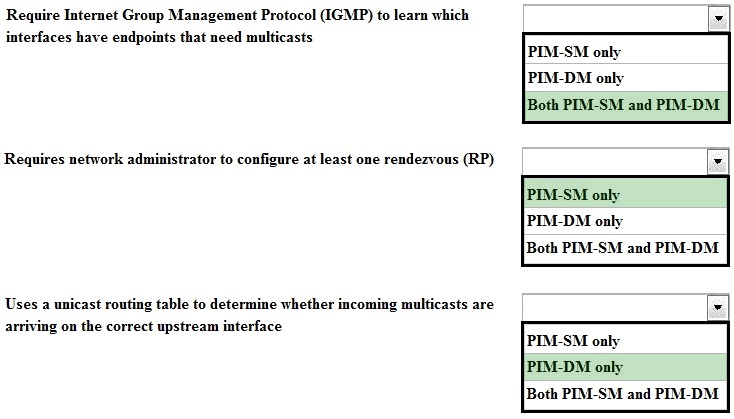HP HP0-Y47 Exam Practice Questions (P. 1)
- Full Access (55 questions)
- Six months of Premium Access
- Access to one million comments
- Seamless ChatGPT Integration
- Ability to download PDF files
- Anki Flashcard files for revision
- No Captcha & No AdSense
- Advanced Exam Configuration
Question #1
Refer to the exhibit.


The switch with the ACL shown in the exhibit has IP address 10.1.4/24 on VLAN 4. It is the default router for 10.1.0/24. A client in VLAN 4 broadcast a DHCP discovery request, and the request arrives on this switch.
What happens?


The switch with the ACL shown in the exhibit has IP address 10.1.4/24 on VLAN 4. It is the default router for 10.1.0/24. A client in VLAN 4 broadcast a DHCP discovery request, and the request arrives on this switch.
What happens?
- AThe ACL processes the packet, and the packet is permitted and then switched.
- BThe switch routes the packet out of VLAN 4 to the VLAN with the DHCP server.
- CThe ACL processes the packet, and the packet is dropped.
- DThe switch floods the broadcast in VLAN 4.
Correct Answer:
D
D
send
light_mode
delete
Question #2
For which use case is a basic or standard access control list (ACL) appropriate?
- AControlling which devices can access other devices based on the MAC addresses
- BControlling which devices can access other devices based on the IP protocol number
- CControlling which devices can access other devices based on the IP addresses
- DControlling which devices can access other devices based on the source VLAN tag
Correct Answer:
C
Access control lists (ACLs) enable you to permit or deny packets based on source and destination IP address, IP protocol information, or TCP or UDP protocol information.
Reference: Chapter 3 Using Access Control Lists (ACLs)
http://www.hp.com/rnd/support/manuals/pdf/release_06628_07110/Bk2_Ch3_ACL.pdf
C
Access control lists (ACLs) enable you to permit or deny packets based on source and destination IP address, IP protocol information, or TCP or UDP protocol information.
Reference: Chapter 3 Using Access Control Lists (ACLs)
http://www.hp.com/rnd/support/manuals/pdf/release_06628_07110/Bk2_Ch3_ACL.pdf
send
light_mode
delete
Question #3
A network administrator is completing an In-Service Software Upgrade (ISSU) for an Intelligent Resilient Framework (IRF) virtual devices. The device has two members. Each member has one management module. Member1 is currently the master. The administrator has initiated a rollback time for this upgrade.
When should the administrator accept the upgrade?
When should the administrator accept the upgrade?
- AAfter upgrading both members of the IRF virtual device
- BAfter checking the new software’s ISSU compatibility but before upgrading either member
- CAfter upgrading member 1 but before switching over to and upgrading member 2
- DAfter upgrading and switching over to member 2 but before upgrading member 1
Correct Answer:
A
Performing an ISSU for a multi-member IRF fabric
ISSU for a multi-member IRF fabric should be performed as per member in two steps: first upgrade a subordinate member, and then upgrade the master and the other subordinate members.
08-ISSU configuration
http://www.h3c.com/portal/Technical_Support___Documents/Technical_Documents/Switches/H3C_S12500_Series_Switches/Configuration/Operation_Manual/
H3C_S12500_CG-Release7128-6W710/01/201301/772597_1285_0.htm
A
Performing an ISSU for a multi-member IRF fabric
ISSU for a multi-member IRF fabric should be performed as per member in two steps: first upgrade a subordinate member, and then upgrade the master and the other subordinate members.
08-ISSU configuration
http://www.h3c.com/portal/Technical_Support___Documents/Technical_Documents/Switches/H3C_S12500_Series_Switches/Configuration/Operation_Manual/
H3C_S12500_CG-Release7128-6W710/01/201301/772597_1285_0.htm
send
light_mode
delete
Question #4
HOTSPOT -
Match each characteristic to the connect multicast routing protocol. If both protocols exhibit characteristic, you must select both.
Hot Area:

Match each characteristic to the connect multicast routing protocol. If both protocols exhibit characteristic, you must select both.
Hot Area:

Correct Answer:

* PIM-SM and PIM-DM
Both PIM-SM and PIM-DM use IGMP.
* PIM-SM
PIM Sparse Mode (PIM-SM) explicitly builds unidirectional shared trees rooted at a rendezvous point (RP) per group, and optionally creates shortest-path trees per source.
PM-DM does not use RPs:
PIM-DM differs from PIM-SM in two essential ways:
1) There are no periodic joins transmitted, only explicitly triggered prunes and grafts.
2) There is no Rendezvous Point (RP).
* PIM-DM
Multicast Routing Information Base (MRIB)
This is the multicast topology table, which is typically derived from the unicast routing table, or from routing protocols such as
MBGP that carry multicast-specific topology information. PIM-DM uses the MRIB to make decisions regarding RPF interfaces.
Reference: https://en.wikipedia.org/wiki/Protocol_Independent_Multicast

* PIM-SM and PIM-DM
Both PIM-SM and PIM-DM use IGMP.
* PIM-SM
PIM Sparse Mode (PIM-SM) explicitly builds unidirectional shared trees rooted at a rendezvous point (RP) per group, and optionally creates shortest-path trees per source.
PM-DM does not use RPs:
PIM-DM differs from PIM-SM in two essential ways:
1) There are no periodic joins transmitted, only explicitly triggered prunes and grafts.
2) There is no Rendezvous Point (RP).
* PIM-DM
Multicast Routing Information Base (MRIB)
This is the multicast topology table, which is typically derived from the unicast routing table, or from routing protocols such as
MBGP that carry multicast-specific topology information. PIM-DM uses the MRIB to make decisions regarding RPF interfaces.
Reference: https://en.wikipedia.org/wiki/Protocol_Independent_Multicast
send
light_mode
delete
Question #5
A company is determining whether HP IMC User Access manager (UAM) meets its needs for a RADIUS server. The company requires a solution for dynamic access control lists based on user identity and location (connected switch ID). Which statement correctly describes UAM support for this requirement?
- AAdministrator can use UAM service and access rules to apply identity-based ACLs. The location-based component is configured in individual switch CLIs.
- BUAM can only meet these requirements if it is synchronized with Microsoft Active Directory (AD).
- CUAM can meet these requirements if the company adds Endpoint Admission Defense (EAD) to the solution.
- DAdministrator can configure UAM service policies, scenarios, and access rules to meet these requirements.
Correct Answer:
D
Endpoint Admission Defense can dynamically deploy ACLs to access devices for dynamic access control.
Endpoint Admission Defense e requires that a fully licensed version of the HP IMC User Access Management (UAM) software module be installed.
Reference: HP IMC Endpoint Admission Defense Software
http://h20195.www2.hp.com/V2/GetPDF.aspx/4AA3-0700ENW.pdf
D
Endpoint Admission Defense can dynamically deploy ACLs to access devices for dynamic access control.
Endpoint Admission Defense e requires that a fully licensed version of the HP IMC User Access Management (UAM) software module be installed.
Reference: HP IMC Endpoint Admission Defense Software
http://h20195.www2.hp.com/V2/GetPDF.aspx/4AA3-0700ENW.pdf
send
light_mode
delete
All Pages
